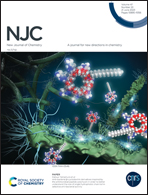The origin of experimental regioselectivity in ring-closing reaction of pyrido[1,2-e]purine systems and comparison of the aromaticity character of probable products: a mechanistic study based on DFT insights†
Abstract
Investigation of the regioselectivity and mechanistic aspects of hydrazine derivatives of pyrido[1,2-e]purine in a ring-closing reaction is the main purpose of this study. The structure possesses two potential nitrogen atoms as nucleophiles in the reaction. Regarding the reported experimental study, one of the nitrogen atoms is a more potent nucleophile. Theoretical studies revealed that the origin of the regioselectivity is rooted in the kinetic parameters of the reaction and the reaction is mainly kinetically controlled. In fact, the steric hindrance of the studied substituents is an effective parameter on the regioselectivity of the ring-closing reaction. Furthermore, the global and local aromatic characteristics of the probable final products were studied. Accordingly, different aromaticity indexes were applied to justify the global and local aromaticity in the obtained products of both the considered routes. Finally, it was concluded that the observed experimental regioselectivity was compatible with the outcomes of the kinetic results. Also, it was revealed that more aromatic products were favorable products, kinetically.
![Graphical abstract: The origin of experimental regioselectivity in ring-closing reaction of pyrido[1,2-e]purine systems and comparison of the aromaticity character of probable products: a mechanistic study based on DFT insights](/en/Image/Get?imageInfo.ImageType=GA&imageInfo.ImageIdentifier.ManuscriptID=D3NJ01276J&imageInfo.ImageIdentifier.Year=2023)


 Please wait while we load your content...
Please wait while we load your content...